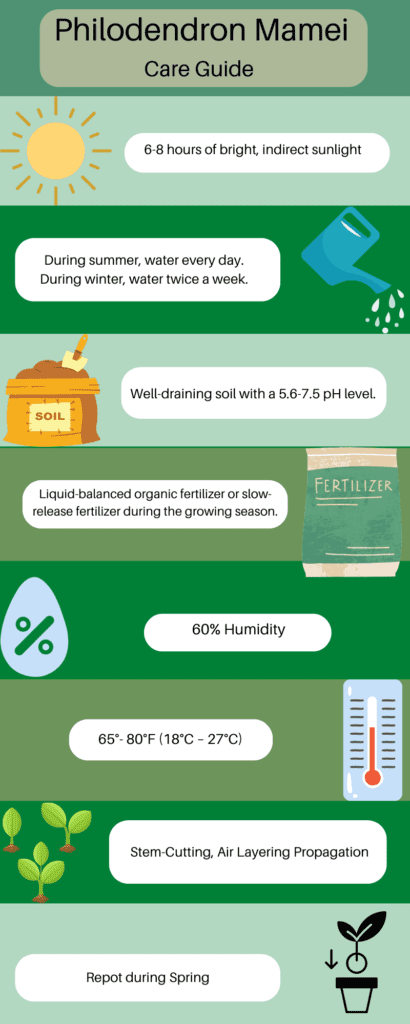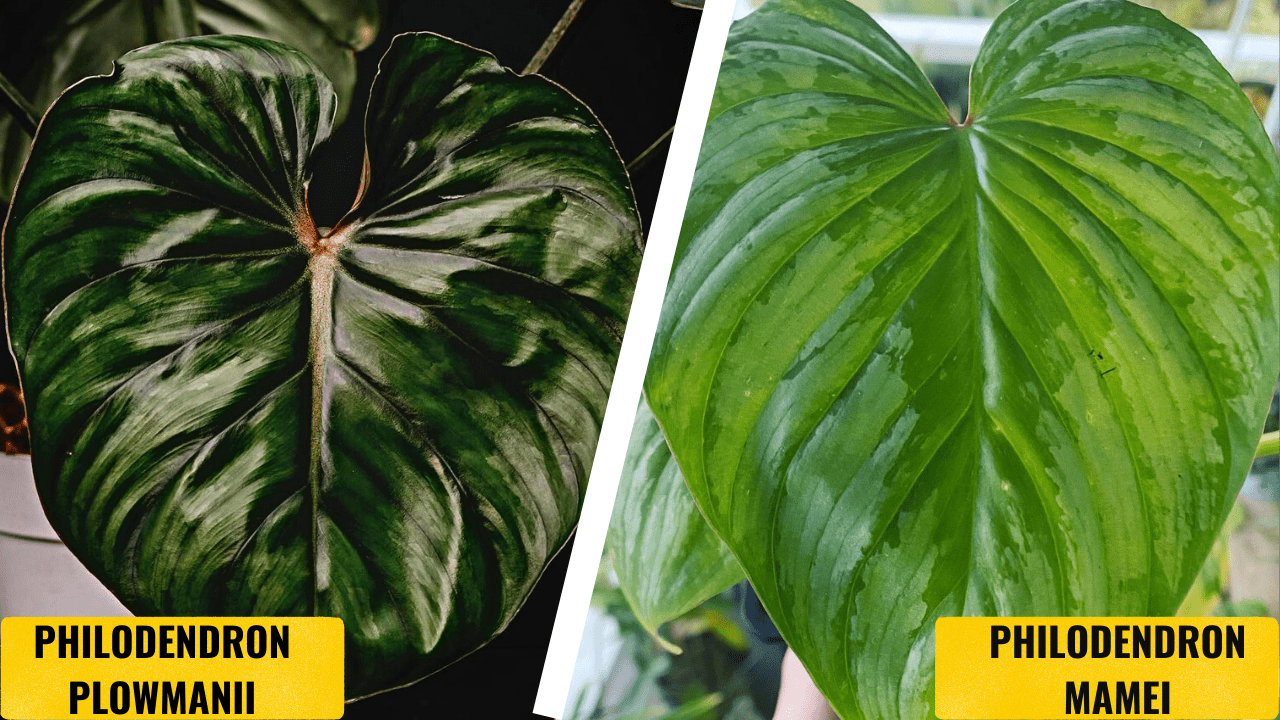Philodendron Mamei also known as Silver Cloud, is a distinctive aesthetic plant that gives your space a tropical look with its creeping habit.
Continue reading to promote Philodendron Mamei with optimum care to leverage the benefits.
Table of Contents Show
Overview of Philodendron Mamei
Native to the Ecuadorian jungle, the unique Philodendron Mamei was first discovered in the late 1800s in the eastern Andes of Ecuador.
| Features | Description |
|---|---|
| Common Name | Silver Cloud |
| Scientific Name | Philodendron mamei |
| Family | Araceae |
| Habit | Lifespan: Tropical Perennial Growth Type: Creeper |
| USDA Zones | Zones 9-11 |
| Native Range | Eastern Andes of Ecuador |
| Growth Rate | Medium-Fast |
| Plant Size | 3 ft 18 in wide |
| Flower | No Flowers |
| Leaf Features | Shape: Green leaves that are dusted with silver. Leaf Size: up to 60.5cm Leaf Width: 56 cm |
| Grown For | Ornamental décor |
| Toxicity | Toxic to cats and dogs |
Philodendron Mamei: Basic Care Guide
Even with a little care and attention, Philodendron Mamei will reward you with lush heart-shaped leaves.

1. Light and Temperature
The Philodendron Mamei thrives in bright indirect sunlight.
If you plan to place your Philodendron outdoors (in zones 9-11), be sure it place it under the shade of a tree.
Too much bright direct light can lead to scorched soil, discolored leaves and dried-out, weak plant. Similarly, low light gives the plant lanky growth, small leaves and a spindly appearance.
Similarly, your Philodendron Mamei produces Silvery variegation to limit its light absorption.
During the day, it can tolerate 86°F (30°C) and around 59°F (15°C) during the nighttime. Anything more will render dehydration in the plant.
However, your Philodendron is sensitive during winter and will suffer if the temperature drops below 55°F (12.75°C).
You can place the plant indoors during winter or use frost blankets to protect it from chilly drafts.
2. Watering and Humidity
Philodendron Mamei weekly watering in summer, watering every two weeks in winter and an average humidity of 60%.
On the other hand, underwatering your plant can cause curling leaves, drooping leaves and stunted plant development.
Water the plant until the water flows from the drainage holes at the bottom of the container.
When there is a low humidity level, the plant’s leaves will start to discolor into brown, and the tips of the leaves will dry up.
Hence you can use a humidifier, mist the plant or DIY a pebble tray to increase the humidity of your Philodendron.
Areas such as the kitchen and bathroom generally have higher humidity levels; thus, your Philodendron will flourish there.
3. Soil and Fertilization
A well-draining soil mix of 5.6-7.5 pH value with a hint of organic matter will be suitable for Philodendron Mamei.
You can create your DIY potting soil by combining 40% coco coir, 15% orchid bark, 15% perlite, 10% worm castings and 10% pumice.
Additionally, you can also purchase reliable potting mixes like Espoma Organic and Sungro Horticulture.
Under-fertilization can affect your plant with a weak stem, stunted development, yellow leaves and fading foliage. Similarly, overfertilizing your Philodendron can cause salt buildup on the soil, root burn, chemical burn spots and droopy leaves.
To avoid this, spread the fertilizer a few inches away from the plant base, soak the soil with water, and let it run down the drain holes for a few minutes.
Additionally, if your House produces a lot of organic waste, you may use banana peels, eggshells, or tea leaves as fertilizer.
You can also purchase commercial fertilizers: Dyna-Gro Grow, Fox Farm, Espoma Organic, and Miracle-Go.
4. Potting and Repotting
It is essential to repot the Philodendron Mamei every two years in a terracotta pot 2-3 inches bigger than the previous one.
Spring or summer is the ideal season to repot your Philodendron in its new home.
Philodendron Mamei does not perform well in wet soil; therefore, you can opt for terracotta, plastic or even clay pot with drainage holes.
Roots emerging from the drainage holes of the plant’s container, slow growth, and loss of the plant’s leaves are some indications to repot your plant.
To lessen the stress of repotting, don’t forget to hydrate the soil the night before.
5. Timely Pruning
You must prune Philodendron Mamei when you notice diseased, discolored, or damaged leaves or once every two years.
Mamei is commonly terrorized by Erwinia blight, Pseudomonas leaf spot, Root Rot and Bacterial Blight.
To prevent diseases, isolate your infected plants and spray copper fungicides.
Additionally, fluctuation in the requirement of your Mamei can become a breeding ground for pests such as Mealybugs, Scales, Thrips, Spider mites and Fungus Gnats.
As a result, it is important to cut the leaves which no longer can develop or are infected with disinfected pruning tools.
You can treat the infestation with insecticidal soaps, neem oil or horticultural oil or use a Q-tip soaked in rubbing alcohol.
Philodendron Mamei: All About the Growth Rate
As an evergreen crawler, Philodendron Mamei is a moderate-fast growing plant.
The 3.2 ft (1m) short stem creeps on the surface and sends roots downward. These stems have weakly ridged medium-green to red colors.
The young leaves of P. Mamei are narrowly oval and have a length of 10.6 inches (27 cm).

The mature Philodendron Mamei has the famous large, green leaves that resemble hearts and are marked with silvery dust streaks.
The plant has large dark green leaves of about 23.8 inches (60.5 cm) in length and width of 22 inches (56 cm).
The leaves could be uneven, with one side slightly broader than the other.
Throughout the spring and summer, you’ll see your plant thriving and expanding quickly; however, the plant will stop you’ll and fall dormant in the winter.
In addition, the plant also develops one or two inflorescences consisting of a supporting peduncle, a spathe, and a spadix.
Toxicity of Philodendron Mamei
Philodendron Mamei is toxic for your pets and humans.
Ingestion might lead to trouble breathing and swallowing, vomiting, nausea, blisters and sour mouth, and diarrhea for your pets.
Similarly, if humans digest the plant’s foliage, it may result in throat and mouth ulcers and skin allergies.
In the case of consumption, visit a doctor if your kids or pets might have accidentally swallowed them.
Here are two helplines you may want to think about in case you want a medical emergency:
- ASPCA Animal Poison Control Center Phone Number: (888) 426-4435
- HRSA toll-free Poison Help line: 1-800-222-1222
Propagation Methods for Philodendron Mamei
You can reproduce the plant by either stem-cutting or the air-layering method during spring or early summer.
One can also propagate Philodendron Mamei through seeds. However, it is a long and uncommon method.
Make sure you have the rooting hormone, containers, suitable soil mix, and garden shears before beginning the propagation procedure.
1. The Stem Cutting Method
Cut a healthy stem at least 1/4 inch below the bottom node on a stem with at least one node.
- Place the roots in a mixture of rooting hormone first, and place it in clean, tepid water in a transparent jar.
- Make sure the leaves are not submerged in the water.
- Look out for root development in about 2-3 weeks.
- The cutting should then be placed in a terracotta container with fresh potting soil.
You can simply propagate the cutting in a soil medium by putting it in fresh soil instead of water.
Position your cutting in a warm location with bright, indirect light, and enclose your plant in a plastic bag. Make sure to poke breathing holes in it.
Since Philodendrons Mamei grows quickly, roots will appear in two to three weeks in a soil medium.
2. Air-Layering Propagation
Check your older leaf nodes for little aerial root extensions.
- Get a transparent plastic bag and poke a few tiny holes at the bottom of it.
- Stuff a handful of thoroughly moisten sphagnum moss in the plastic bag.
- Cut the plastic bag’s top end to create flaps that can be rolled around the stem.
- Place the bag of sphagnum moss against the aerial root and wrap the plastic flaps around the stem.
- After 2-3 weeks, you’ll notice that the moss has roots growing into it.
- Gently remove the moss and split the cut below the new roots.
- Then, pot the plant in a new container with a well-draining soil mix.
Philodendron Mamei for Sale
Here are a few websites where you may buy Philodendron Mamei.
| Places to Buy | Expected Delivery Period |
|---|---|
| Aroid Market | 4-7 days |
| Plantipus | 6-7 days |
| Etsy | 2 weeks |
| KensPhilodendrons | 9 days |
| Ecuagenera | 15 days-1month |
Philodendron Mamei Vs. Plowmanii
The close resemblance in the glossy, dark green heart-shaped foliage of both Philodendron Plowmanii and Mamei can generate confusion to the general eye.
However, a few details can help you distinguish between the two Philodendrons.

| Features | Philodendron Plowmanii | Philodendron Mamei |
|---|---|---|
| Leaf | Size: 7-15 inches Variegations: Creamy White Veins: Secondary veins are less noticeable and widely dispersed. | Size: 23.8 inches Variegations: Silvery Grey Veins: Closely spaced veins with prominent secondary veins. |
| Growth Rate | Slow growth | Moderate growth |
| Mature Size | 8 ft | 3.2 ft |
| Petioles | Ruffled edges | Smooth |
Philodendron Mamei Vs. Sodiroi
Both Philodendron Mamei and Sodiroi belong to the same Araceae family, making their leaves structure similar.
However, one can still see the following differences between these two.
| Features | Philodendron Sodiroi | Philodendron Mamei |
|---|---|---|
| Leaf | Size: 8 inches Leaf Texture: Smooth, shiny leaves | Size: 23.8 inches Leaf Texture: hairy leaves |
| Petioles | Texture: Rough Color: Red/Pinikish with less extreme mottlings Veins: laterally spaced veins | Texture: Smooth Color: Dark green/Olive Veins: Closer lateral veins |
| Growth Habit | Vine-like | Shrub-like |
| Mature Size | 5ft 8inches | 3ft 18 inches |
Winding Up
The silvery streaks in the heart-shaped leaves of Philodendron Mamei are unique and attractive but dangerous. Therefore, be mindful of children and pets.
It is a creeper, so provide a moss pole to support its luscious leaves and keep them healthy.
Happy Gardening!


